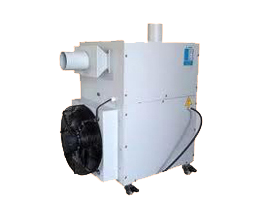AIR CHILLERS WITH HUMIDITY CONTROLLED

Air conditioning is the process of eliminating moisture and heat from enclosed spaces in order to offer interior comfort. Air conditioning is used in both business and home settings. It is often utilized to provide a comfortable atmosphere for human employment. They are also utilized in interiors with considerable heat output, such as areas with an abundance of computers, servers, and amplifiers. They come in a variety of sizes to suit their intended function, ranging from a tiny room to a large warehouse. It also protects against germs found in ambient air by keeping them outside of the inner systems. Commercial-scale air conditioning systems are used in a variety of sectors for research, product preservation, specimen storage, and other purposes.
Chillmax Innovations is a prominent air chillers manufacturers in India and an air blast oil cooler maker in India, supplying all types of air chillers to various areas of India. Our solutions are utilized to dissipate the heat produced during operations.
Experts in Air chiller manufacturing
We have experience in designing chiller systems for industrial applications. So, we are capable of keeping your equipment cool even at peak output. Our industrial chillers are delivered as a complete boxed unit that can be simply placed into position and turned on. The interior tank maintains a cold-water temperature of ±1°F to avoid temperature spikes across many activities. You can rely on us to provide dependable and customized solutions for all industrial process cooling needs. Our chillers handle the warmth so you do not have to! Our Air Chillers are used in various industries across India including Bangalore, Mumbai, Chennai, Pune, Coimbatore, Hyderabad, Kolkata, Faridabad, Ahmedabad, Surat, Rajkot, New Delhi, Lucknow, Kanpur, Noida, Gurgaon etc.
How do industrial air chillers work?
Industrial operations produce heat by continuous machine operation. Our industrial air chillers employ process cooling to remove heat from the equipment. They assist to extend the life of the components and keep manufacturing going. Process chillers differ from the usual HVAC systems found in your house or workplace. A pumping system transfers cool fluid through a chiller to your operation, removing heat, and then returning the warm fluid to the chiller. Your equipment will remain cool since the process water removes heat. Process industrial chillers consist of four major components, each of which plays an important part in the chilling process:
- Evaporator- As the initial stage in the cooling stage, process water reaches the evaporator, where heat begins to evaporate the refrigerant, converting it from a liquid with a low pressure to an a low-pressure gas.
- Compressor- Within the compressor, gas is converted from low to high pressure before flowing to the condenser and releasing heat.
- Condenser- Air in the environment cools the high-pressure gas, causing it to condense into low-pressure or low temperatures liquid.
- Finally, the fluid refrigerant goes to the expansion valve, where it enters the evaporator unit and the cycle begins again.
Our high-efficient Air chillers
Chillmax Air Cooling systems are VFD-controlled and built for exact temperature. We deliver flow of cool air in specialized applications such as plastic blown film facilities. Our Industrial chillers are up to 50% more energy efficient than standard air cooling systems that use water-cooled chillers in conjunction with air exchangers. It is because the outside temperature and RH fluctuate constantly. Our Industrial Process chiller is intended to function within the desired temperature range, with automated capacity control ranging from 40% to 110%.
- Reliable and energy-efficient compressors
- R-407C, R-410A, and R-134a are environmentally friendly refrigerants that are available.
- Designed for accurate air temperature outlet range, up to 48oC ambient temperature, and 90% relative humidity.
- Energy savings of up to 50% as compared to standard indirect air conditioning systems.
- VFD-based design for improved temperature control and increased efficiency is available.
- Compact design with a smaller footprint and fewer maintenance costs.
